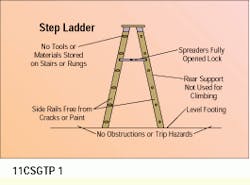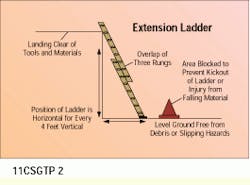Maintaining and using a ladder safely
Brian Kingman,
Consolidated Services Group
Problem
According to an April 1995 Bureau of Labor statistics release, 20% of all reported falls were from ladders and 55% of ladder injuries were in the construction trades.
Solution
When using a ladder at a job site, installers should inspect and use ladders properly as prescribed in the Occupational Safety and Health Administration (Washington, DC) regulations.
Procedure
1) Before using a ladder, inspect it for the following conditions:
Ladders should
--be free from oil, grease or similar materials
--have rounded corners to prevent snagging of clothing
--be properly rated for weight capacity
--have non-conductive side rails when used around energized circuits.
Ladders should NOT be
--painted with any type of opaque substance that may obstruct inspection for cracks or defects
--missing any steps or supports.
2) Basic safety tips for using a step ladder include the following:
--Do not use a ladder if the side rails are broken, cracked or damaged in any way.
--Open the ladder fully with the retaining arms extended and locked in place.
--Use only on a level surface.
--Always face the ladder when climbing the steps.
--Do not stand above the safe working height of the ladder.
--Only one person should be on a ladder at any time.
--Always move ladders in the closed position.
--Do not use ladders as supports for staging or to support cable reels.
--Never leave tools or stock on stairs or rungs.
3) When using an extension ladder, the following safety rules apply:
--All entrance and exit areas to and from the ladder should be clear of tools, materials and other obstructions that may contribute to someone`s falling.
--Do not use the ladder on any surface that does not equally support the side rails.
--Extension ladders should have non-slip footing to prevent kickout.
--Tie off the extension rope to the bottom section when the ladder is extended.
--The top of the ladder should extend 36 inches above the working surface.
--The rail section should overlap a minimum of three rungs when extended.
4) The OSHA regulations also require an employer to provide training to employees in the following areas with respect to ladder safety:
--Identifying potential fall hazards
--Proper procedures for use and maintenance of fall protection
--Proper inspection, use and placement of ladders
--Load-carrying capacity of ladders
These tips in no way represent a complete list of the types of ladders and requirements for inspection and safe use as set out by the OSHA regulations. Refer to the OSHA standards to ensure your safety and your company`s compliance.
Spreaders on a step ladder should always be fully extended and locked.
An extension ladder should be positioned one foot horizontally for every four feet it is extended vertically.
Brian Kingman is safety officer at Consolidated Services Group Inc., Norwood, MA


